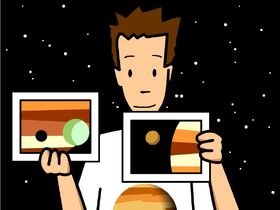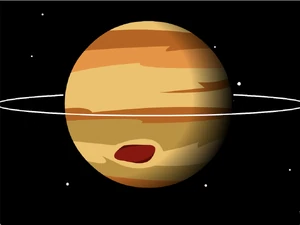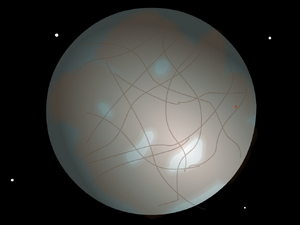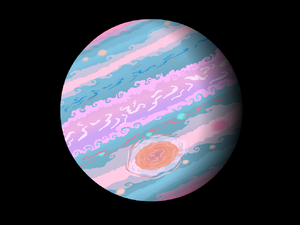| Jupiter | |||
|---|---|---|---|
 | |||
| Airdate | September 25, 2001 March 6, 2019 (Update) | ||
| Curriculum | Science | ||
Jupiter launched in BrainPOP Science September 25, 2001. An update launched in March 6, 2019.
Summary[]
Original[]
Tim is reading a letter and discusses about Jupiter with Moby.
At the end, Moby tells Tim that he wants to change his name to Jupiter; Tim won't let him. When Moby tries again, Tim replies "I'm not calling you Jupiter."
Update[]
Tim has to wait to take a dive into the pool. As soon as Tim reaches 0.9 to an original 0, Moby peeps.
At the end, Moby makes all the lights come on during darkness.
Appearances[]
Transcript[]
Quiz[]
Quotes[]
Old[]
- Tim: [Moby beeps] What? [Moby beeps] No. You can't change your name to Jupiter. [Moby beeps] You just can't! I'm not calling you Jupiter.
Update[]
- Tim: 3, 2, 1, 0.9, 0.8, 0.7...
- [last lines]
FYI[]
Graphs, Stats and Numbers[]

Jupiter seems larger than life, but what do the numbers say? Here are some stats about the solar system’s most massive planet:
142,984: Diameter of Jupiter in kilo meters.
6.22 × 10^10: Surface area of Jupiter in square kilo meters.
1.43 × 10^15: Volume of Jupiter in cubic kilo meters.
1.8986 × 10^27: Mass of Jupiter in kilograms.
-148: Average surface temperature of Jupiter in degrees Celsius.
10: Number of hours in a day on Jupiter.
11.862615: Number of Earth years it takes Jupiter to orbit the Sun.
90: Percentage of Jupiter's atmosphere that's made of hydrogen.
In Depth[]

As Tim mentions in the movie, the Great Red Spot is a gigantic storm in Jupiter’s southern hemisphere. It’s shaped like an oval, around 15,000 kilo meters in diameter at its widest point. And it rotates counterclockwise, completing a full rotation every six Earth days.
Storms like the Great Red Spot are fairly common on Jupiter. They’re formed when the hot gases in the planet’s atmosphere rise and begin swirling and coming together as they move. The clouds above the hot gas prevent energy from escaping into outer space. That’s why storms on Jupiter can last hundreds of years, possibly even longer!
The Great Red Spot has been observed consistently from 1878 onward. Some astronomers believe it’s been around even longer. For a long time, scientists thought it might be a geological or liquid feature. But in 1979, the Voyager 1 space probe passed by Jupiter and took some incredible photos. They confirmed that the Great Red Spot is a storm!
Scientists have since learned more about the Great Red Spot. A robotic probe called Juno was sent to discover its depth. When Juno passed over the storm in July 2017, the probe found the storm's roots are 50 to 100 times deeper than Earth's oceans!
Despite its impressive depths, scientists have also observed that the Great Red Spot is shrinking. Some say it could even disappear entirely within your lifetime!
Not Solved Mysteries[]

Earth is the only place in the solar system where we know living organisms exist… at least, so far. Another spot that planetary scientists think organisms could survive is on Jupiter’s 4th-largest moon called Europa.
Europa is made up of similar materials as Earth and the other terrestrial planets. Like our home planet, the moon’s interior consists mainly of silicate rock, and researchers believe it also has an iron core. But unlike Earth, Europa has a very thin atmosphere that’s mainly oxygen gas. That makes it way too thin for humans to breathe—but other life forms may be able to survive there.
The most important requirement for life is liquid water. The surface of Europa is covered with an icy crust, and many scientists believe that there’s a liquid ocean of salty water underneath it. Anything capable of surviving there would probably be similar to the types of life found in the deepest parts of Earth’s oceans.
If there is liquid water on Europa, that could explain the moon’s striking surface fractures. As Europa moves through its orbit, Jupiter’s intense gravity would pull that water towards the planet, causing strong tides. Tidal forces below Europa’s surface could create the large cracks we see in the ice above.
Scientists already have plans to gather new information on Europa’s potential liquid ocean. The Europa Clipper mission is scheduled to launch in the 2020's. It will then take several years to get to Jupiter. Clipper will be equipped an ice-penetrating radar that will search for lakes below Europa’s icy surface, as well as cameras and other instruments. Its measurements will help answer the question of whether living things could survive in this faraway world.
Quirky Stuff[]

Jupiter is a multi-colored planet, with stripes of red, orange, yellow, white, and brown. The colors come from molecules in the planet’s atmosphere. The white bands get their color from small amounts of ammonia, for example. And the orange originates from dashes of a related molecule called ammonium hydro sulfide. Yet many images of Jupiter, like the one pictured here, show false color. In other words, the colors have been artificially altered or added. Similar to how you might add a filter to a photo on a social media app, astronomers use filters and other techniques to create false color. But why?
Scientists sometimes use false color to hide or highlight particular features in a photo, depending on what they’re studying. For example, if they’re looking for deposits of a blue mineral on a planet’s surface, they might bump up the intensity of all shades of blue. This would make those blue minerals easier to spot.
False colors can also create a visual representation of data. If you’ve ever watched a TV weather report, you’ve probably seen examples of this. The colorful storms shown moving across the map are not what storms actually look like, of course. Rather, they’re false color versions that indicate where the storm is most intense. A meteorologist could instead display a big table of data about the storm’s intensity. But the map visualization is a clearer, more powerful way to convey this important information to viewers.
Similarly, astronomers created the false color image shown here in order to understand Jupiter's clouds. The reddish parts are areas where clouds are reflecting more infrared light. That's a color of light that the human eye can't detect. You may have heard of it being used in night vision goggles or cameras to reveal what’s lurking in the dark. It’s especially useful for studying Jupiter’s clouds because the clouds reflect infrared light even when there’s no sunlight there.
Using a robotic probe, astronomers gathered data on the infrared light coming from Jupiter. Then, they mapped that information onto a photo using false colors. So, instead of sorting through a big table of data, they can simply look at the false color image and see where Jupiter's clouds reflect more infrared light.
Scientists use this technique to study all kinds of things, from the stars in the sky to the cells in our body. Biologists often use false color images to show where a particular kind of molecule is found within a cell. If it’s only found within certain cellular structures, for instance, that’s a clue about how the cell uses that molecule. In science, a picture is sometimes worth a thousand data points.
Discoveries And Inventions[]

As of 2018, 79 moons of Jupiter have been discovered—and there may be even more that we haven’t seen yet! The Jupiter moon count began in 1610. That’s when the famed Italian astronomer Galileo Gal i lei discovered the four largest with his telescope.
Galileo originally named these moons after the wealthy Medici family, who helped fund his research. Today, they’re known as the Galilean moons. German astronomer Simon Marius named them Io, Ganymede, Callisto, and Europa, after four of Jupiter’s lovers from Roman mythology.
It wasn’t until 1892 that a fifth moon, Am a l t h ea, was discovered, by American astronomer E.E. Barnard. As telescope technology improved during the 20th century, more moons were discovered; by 1975, the total had jumped to 13. Then in 1979, the Voyager I spacecraft made a close approach to Jupiter, revealing the existence of three more moons.
The moon count jumped dramatically at the turn of the 21st century. In 1999, University of Arizona’s Space watch program realized that an asteroid they’d recently discovered was actually a small Jovian moon. This inspired a team of researchers at the University of Hawaii to begin searching for more. Between 2000 and 2003, the team discovered 46 Jovian moons, which brought the total to 63. Most were tiny, with an average diameter of under three kilo meters. These moons are now known as the Par sip ha e group. They are believed to have originated when Jupiter’s gravity “captured” remnants of an asteroid that broke up after a collision.
As technology improves, so does the potential for new discoveries. In 2017, a team of astronomers from the Carnegie Institution of Science found 10 new moons—including one that is a bit of a contrarian: Va let u do orbits Jupiter in the opposite direction of all the other moons! Lead astronomer Scott Sheppard described its path as "like driving down the highway the wrong way."* He thinks Va let u do could be the key to explaining Jupiter’s many moons: This one could have collided with others, breaking them into smaller pieces—and creating new moons.
In the tradition begun by Galileo and continued by every astronomer since, Sheppard named the moon he discovered after a Roman god connected to Jupiter. But with 78 other moons claiming the names of Jupiter's closer relatives, Sheppard had to turn to the farther reaches of the family tree: Va let u do was Jupiter's great-granddaughter!
* Source: Vox . com
FYI Comic[]

